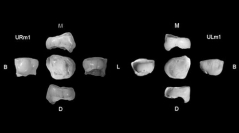

 Comptes Rendus Palevol
9 (6-7) - Pages 341-348
Comptes Rendus Palevol
9 (6-7) - Pages 341-348The present study of three human upper deciduous molars from the early Middle Pleistocene site of Tighenif, Algeria, constitutes the first microtomographic-based endostructural exploration of African fossil teeth likely representative of the Homo heidelbergensis morph. Comparative morphological observations and 2-3D measurements describing subtle tooth organization (crown tissue proportions) and enamel thickness topography (site-specific distribution and global patterning) indicate that their virtual extracted structural signature better fits the modern human, rather than the Neanderthal condition. Accordingly, we predict that the inner structural morphology of the deciduous molars from the Middle Pleistocene western European series better fits the primitive, and not the derived Neanderthal figures.
Human deciduous molars, Tissue proportions, Enamel thickness, Tighenif, Early Middle Pleistocene, Microtomography